October 20-21, 2005
Abstracts
Limb-Darkening Observations Testing State-of-the-Art Model Atmospheres
Jason P. Aufdenberg
Models for stellar limb darkening play an important role in the reduction of light curves for transiting planets, eclipsing binaries and gravitational microlensing. Direct interferometric limb-darkening observations (in the 2nd and higher lobes of the visibility curve) have been until quite recently been limited to a small number of giant stars cooler than the Sun. Observations at shorter wavelengths and longer baselines are now obtaining 2nd lobe visibility measurements for stars in regions of the HR diagram previously untouched by interferometry. I will describe an observational program with the CHARA Array and FLUOR beam combiner to obtain 2nd lobe visibility measurements of B- and A-type supergiants, and F-type stars. Such high precision observations provide tests of predictions of fundamental phenomena such as stellar mass loss and atmospheric convection. Observations of blue supergiants Rigel and Deneb are providing the first tests of expanding model atmosphere limb-darkening predictions. Observations of the F-type subgiant Procyon allow us to test 3-D hydrodynamical models used to study Sun. Such models have recently substantially revised the abundance of CNO in the solar atmosphere and are therefore of fundamental importance. Observations of Procyon from the Mark III, VLTI, and CHARA interferometers will be shown in comparison to 1-D and 3-D model atmosphere predictions.
 Towards
1010
Contrast for
Terrestrial Exoplanet Detection: Coronagraphy Lab Results and Wavefront
Control Methods
Towards
1010
Contrast for
Terrestrial Exoplanet Detection: Coronagraphy Lab Results and Wavefront
Control Methods
Ruslan Belikov, Jeremy Kasdin, Robert Vanderbei, Michael Carr, Michael Littman, Amir Give’on, Jason Kay, Laurent Pueyo
NASA’s Terrestrial Planet Finder Coronagraph (TPF-C) requires a high contrast imaging system capable of attaining a contrast ratio of 1010. We are investigating two solutions: the Shaped-Pupil Coronagraph (SPC) and Phase-Induced Amplitude Apodization (PIAA).
At the heart of SPC is a specially designed shaped mask in the pupil plane that creates a high-contrast point spread function in the image plane. We have manufactured a mask designed to give 1010 contrast at working angles from 4 to 100 lambda/D. With this mask, we achieved a contrast of 3x10-6 at 5 lambda/D, limited by uncorrected mirror aberrations.
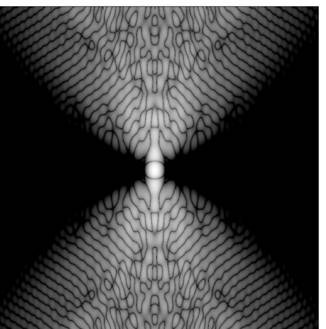 At
the heart of the PIAA approach are two specially curved mirrors that
effectively create the desired pupil apodization. A substantial
advantage of PIAA over SPC is that it does not lose any light. However,
PIAA suffers from contrast-degrading Fresnel effects and sensitivity to
wavelength. Whether or not these issues can be overcome is an open
question.
At
the heart of the PIAA approach are two specially curved mirrors that
effectively create the desired pupil apodization. A substantial
advantage of PIAA over SPC is that it does not lose any light. However,
PIAA suffers from contrast-degrading Fresnel effects and sensitivity to
wavelength. Whether or not these issues can be overcome is an open
question.
Either method will require an extreme adaptive optics system capable of correcting mirror phase aberrations to lambda/104 and amplitude aberrations to 1 part in 103. Furthermore, estimation of both aberrations has to be done with minimal photon loss, and the correction of amplitude aberrations has to work on polychromatic light. We are proposing a hybrid wavelength-defocus diversity method for estimation and a spatial dithering method for amplitude control.
Standing on the Shoulders of Cool Dwarfs: Directly Measured Diameters of Low-Mass Main-Sequence Stars
David H. Berger, H.A. McAlister, T.A. ten Brummelaar, D.R. Gies, T.J. Henry, L. Sturmann, J. Sturmann, N. Turner, C. Ogden, S. Ridgway, J. Aufdenberg, A. Mérand
We present diameters of seven low-mass main-sequence stars as measured by the CHARA Array, a six-telescope long baseline optical interferometer located at Mount Wilson Observatory. Spectral types ranged from K7 to M3.5 with six of the stars being of type M. This data represents a near doubling of the number of directly measured diameters at the cool end of the H-R diagram. We employed the use of the two longest baselines at K’-band, which was well-suited for angular diameters ranging from 0.5 to 1 milliarcseconds. For GJ 15A, our result was consistent to within 1 sigma of a measurement with the Palomar Testbed Interferometer (PTI). The measured diameters of cool stars and their calibrators also support recent surface brightness relations. Combining data from the PTI and the Very Large Telescope Interferometer (VLTI), we derived an empirical recalibration of the mass-radius-luminosity relation for cool stars. We discuss a potential disparity between diameters measured by interferometry and those in eclipsing binary systems as shown by our data. The scientific and technical impact of the newly commissioned R/I-band low resolution spectrograph used in conjunction with longitudinal dispersion compensators is also presented.
Speckle Nulling with Space-based Coronagraphs
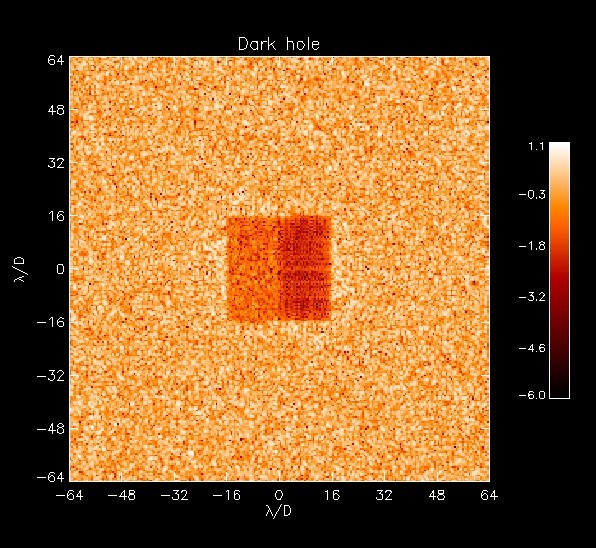 Pascal Bordé
Pascal Bordé
Detecting
Earth-like planets in the visible with a coronagraphic telescope
implies that we must attain a contrast (star-to-planet luminosity
ratio) on the order of 1e10 or higher. Two major noise sources have to
be overcome: the photon noise of the diffracted star light, and the
speckle noise due to the star light scattered by instrumental defects.
Coronagraphs tackle only the photon noise contribution. In order to
decrease the speckle noise below the planet level, an active control of
the wavefront is required. Wavefront sensing should be done directly
with the scientific image, because a separate optical arm would
introduce its own wavefront defects. I will present analytical methods
to measure and correct the speckle noise behind
an ideal coronagraph in a low aberration regime using only three images
(no iterative process needed). The only hardware required is the
coronagraph deformable mirror and an imaging detector in the focal
plane, thus there are no non-common path errors to correct. Numerical
simulations show that these methods can improve the contrast by two to
three orders of magnitude without
pupil apodization.
Measuring Gas in Planet Forming Disks
Sean Brittain
Gas in the inner 50AU of a young protoplanetary disk comprises most of the mass of the disk and subsequent planets, but it is not clear if gas survives long enough, with sufficient density, to make current theories of planet formation viable. Recent interferometric observations of circumstellar disks have generated useful measurements of the inner radii of the disks. Coupled with the direct measures of H2 provided by the FEPS Spitzer Legacy Project, which provide a more robust measure of the total gas mass, these efforts will guide our understanding of circumstellar evolution. High-resolution spectra of fundamental CO ro-vibrational lines complement both these observations by providing a sensitive probe of the distribution of gas in the inner few AU. Ro-vibrational CO line emission provides the most sensitive probe of excited molecular gas in disks; its diverse excitation mechanisms can be disentangled spectroscopically and provide a unique view into the clearing of circumstellar matter due to radiation and planet formation. We will present near infrared high-resolution spectra of circumstellar disks and highlight the information about the planet-forming environment that can be gleaned from this data. We will also discuss the progress being made on bringing these observations and models of gas in disks together.Challenges in Coronagraphic Astrometry
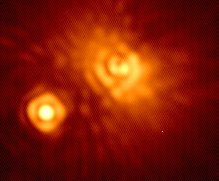 Andrew Digby
Andrew Digby
The efforts of high-resolution, high-contrast coronagraphic imaging surveys are fast yielding images of sufficient quality to directly detect planet-sized companions to other stars. However, in the race for primacy and dynamic range, there is an inherent danger in overlooking details which are crucial to understanding these images, and in neglecting other important science they may contain.
Such ‘extreme AO’ (exAO) coronagraphic images are very complex, with much poorly-understood atmospheric and instrumental structure. Better understanding of these images is necessary for optimizing the return from the current generation of instruments, and for designing the next generation of coronagraphs which will work at extremely high dynamic ranges.
Some of the astrometric issues faced in exAO coronagraphic images will be presented by means of new data from the Lyot Project, a program which is using the world’s first diffraction-limited and fully-optimized coronagraph to search for faint companions and disks around nearby stars.
Probing Sub-AU Radii of Young Circumstellar Disks: Observations with the Keck and Palomar Testbed Interferometers
Josh Eisner
The structure of young circumstellar disks, and in particular of the regions within 1 AU of the central star, has important implications for disk accretion and planet formation. We have observed a sample of T Tauri and Herbig Ae/Be stars with the Keck and Palomar Testbed Interferometers, supplemented by echelle spectroscopy and optical through near-IR photometry. With these data, we constrain the geometries and temperatures of inner circumstellar dust disks, and compare our measurements with the predictions of physical disk models. Analyzing our measured inner disk properties with those expected for magnetospheric accretion models, we find evidence that gaseous disk material extends further in toward the star than dust. Finally, we discuss implications for terrestrial planet formation and the migration of giant planets.
Wavefronts:
Peak-a-boo, I'll Correct You
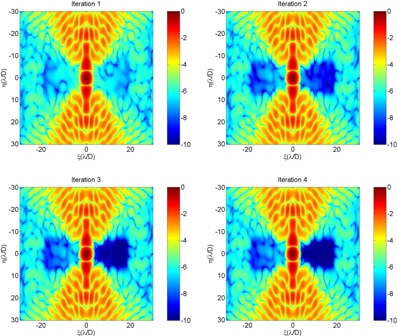 Amir Give’on
Amir Give’on
Conventional adaptive optics systems correct the wavefront by adjusting a deformable mirror based on measurements of the phase aberration in a pupil plane. The ability of this technique, known as phase conjugation, to correct aberrations is limited and insuffcient for high contrast imaging due to the frequency folding phenomenon. We present an alternative solution for the shape of the deformable mirror using an innovative estimation technique based on wavelength and defocus diversity and a correction technique based on the Fourier decomposition of the effective phase and amplitude aberrations.
Information-based assessment of optical synthesis images
Douglas Hope
Optical synthesis images are obtained by Fourier transformation of the measured complex fringe visibility. Due to the limited number of such measurements synthesis imaging is an ill-posed inverse problem. In such problems it is important to obtain an image that is both consistent with the observed data and any prior information or constraints on the object. This is accomplished through self-calibration, which uses modeling, closure phases and deconvolution to iteratively improve the image quality. A general problem with this process is that there are no robust criteria to advise the observer when the procedure has converged. Only a proper implementation of reliable prior knowledge can serve to constrain the reconstructed image.
We propose such an implementation based on statistical information. In our approach an interferometer array is modeled as a communication channel. Information about the object is passed by the array in the form of the complex fringe visibility measurements. Since there are a limited number of measurements, not all of the object information will be passed by the array. The process of self-calibration partially recovers this lost information by injecting prior information about the object into the image. The amount of object information recovered can be used as a metric for monitoring and stopping the self-calibration process, once the information has reached a maximum. This information-based approach may provide new and valuable tools for optimizing synthesis imaging.
The potential for Optical Interferometric Polarimetry to detect scattered light from disks and exoplanets
Mike Ireland
Optical Interferometric Polarimetry (OIP) is a differential technique for separating scattered light with a signal in Stokes Q and U from bright stellar photospheric flux. I will discuss how this technique can be used to detect scattered light from the inner regions of circumstellar disks, even where the symmetry of the disk may mean that there is no net polarized signal. The implementation of OIP will require only small modifications to existing interferometers, and can offer superior contrast ratios when compared to other differential techniques such as differential phase and closure phase. Finally, I will discuss the potential of OIP for exoplanet characterization and how it could play some part in exoplanet detection despite its lower photon-limited sensitivity when compared to Stokes I techniques.
Quadarature phase interferometery: Squeezing more out of rotation shearing interferometry
Brian Kern
We have developed a new technique of visible light pupil-plane rotation-shearing interferometry for single apertures, capable of measuring visibility modulus and phase over the entire (u,v)-plane (up to the telescope cutoff frequency) instantaneously. The interferograms are arranged so that each baseline is simultaneously measured with four different instrumental phase contributions, effectively performing spatially-multiplexed fringe scanning. Diffraction-limited images can then be obtained after removing the atmospheric phase contributions from a large number of individual short exposures. This technique has been demonstrated in the laboratory and at the Palomar 200-inch telescope, with notable success. With the addition of spectral information, this technique has the potential to perform differential phase measurements of hot Jupiters at Keck, providing orbital inclinations (and therefore masses) as well as low-resolution visible spectra of the most favorable planets.
Transiting extrasolar giant planets
Maciej Konacki
The discovery of hot Jupiters (1995) and successful detection of the transit of HD 209458b (1999) motivated a number of systematic transit monitoring programs. Photometry of transiting planets combined with radial velocities yields radii, masses and densities of giant planets. In 2002, the OGLE team announced detections of 58 candidate planetary occultations in three fields in the direction of the Galactic center. However, the photometric observations alone cannot distinguish between Jupiter size planets, brown dwarfs and late type M dwarfs since they all have similar radii (few tenths of solar radius). Therefore, I have initiated the first high-resolution spectroscopic follow-up (with Keck/HIRES) of OGLE candidates to measure the radial velocities and hence determine the masses of their dark companions. This effort resulted in the discovery of the first transiting planet proposed by a photometric survey, OGLE-TR-56b in 2003 and two more OGLE-TR-113b (with Magellan/MIKE) and OGLE-TR-10b in 2004. Altogether, we now know seven transiting extrasolar giant planets. I will review the current state of this field and in particular what we have learned from the searches for transiting giant planets.A Summary of Results from Nulling Interferometry: 2001 - 2005
Wilson M. Liu (current fellow) and Philip M. Hinz (past fellow)
We present results from 10 _m nulling interferometric observations using the BLINC-MIRAC instrument on the MMT and Magellan I 6.5 m telescopes over the past four years. A recently completed survey of Herbig Ae stars has led to the detection of resolved disks around AB Aur, V892 Tau, and HD 100546. We will discuss the results of this survey, including the physical characteristics of the resolved disks and their significance in the context of planet formation. We will also present an overview and results from an ongoing survey of main sequences stars for exozodiacal dust, utilizing the powerful combination of nulling interferometry and the adaptive optics secondary at the MMT. Recent observations of the star Vega have allowed us to constrain the level of warm dust in the system to below 2.1% of the stellar at 10 _m. The overall goal of this survey will be to characterize the prevalence of exozodiacal dust for nearby stars, allowing us to place our own solar system into context as well as establishing criteria for future searches for exosolar terrestrial planets.
Precision Radial Velocity Surveys with Fixed Delay Interferometers: The Potential of a Multi-Object Radial Velocity Instrument
Suvrath Mahadevan
The ET (Exoplanet Tracker) instrument installed at the KPNO 2.1m meter is a fixed delay interferometer coupled to a medium resolution spectrograph. Radial velocity is measured as a shift in the phase of the interference fringes recorded on the CCD. This instrument allows extremely high throughput, has demonstrated its radial velocity short term precision of 3m/s and has already discovered candidates worthy of follow up. The Michelson interferometer allows the high frequency information to be heterodyned to lower frequencies and eliminates the need for a high resolution spectrograph.A prototype multi-object radial velocity instrument based on ET has recently been deployed on the SLOAN 2.5m telescope and has achieved first light with 10 objects. This talk will focus on the the principle of these novel instruments as well as the instrumentation efforts to develop a passive stabilized interferometer. The development of a new multi-object instrument capable of observing 50-100 stars with a high velocity precision is the ultimate goal of this project and this is already underway.
The Multi-object radial velocity instrument has the potential to dramatically increase the speed of radial velocity surveys and the simultaneous use of the SLOAN spectrographs allows R=2000 spectroscopy of more that 600 additional stars in the 7 square degree field with no additional time. I will discuss this in the context of spectroscopy of stars in the KEPLER field.
High Resolution Imaging of Debris Disks in the Mid-Infrared
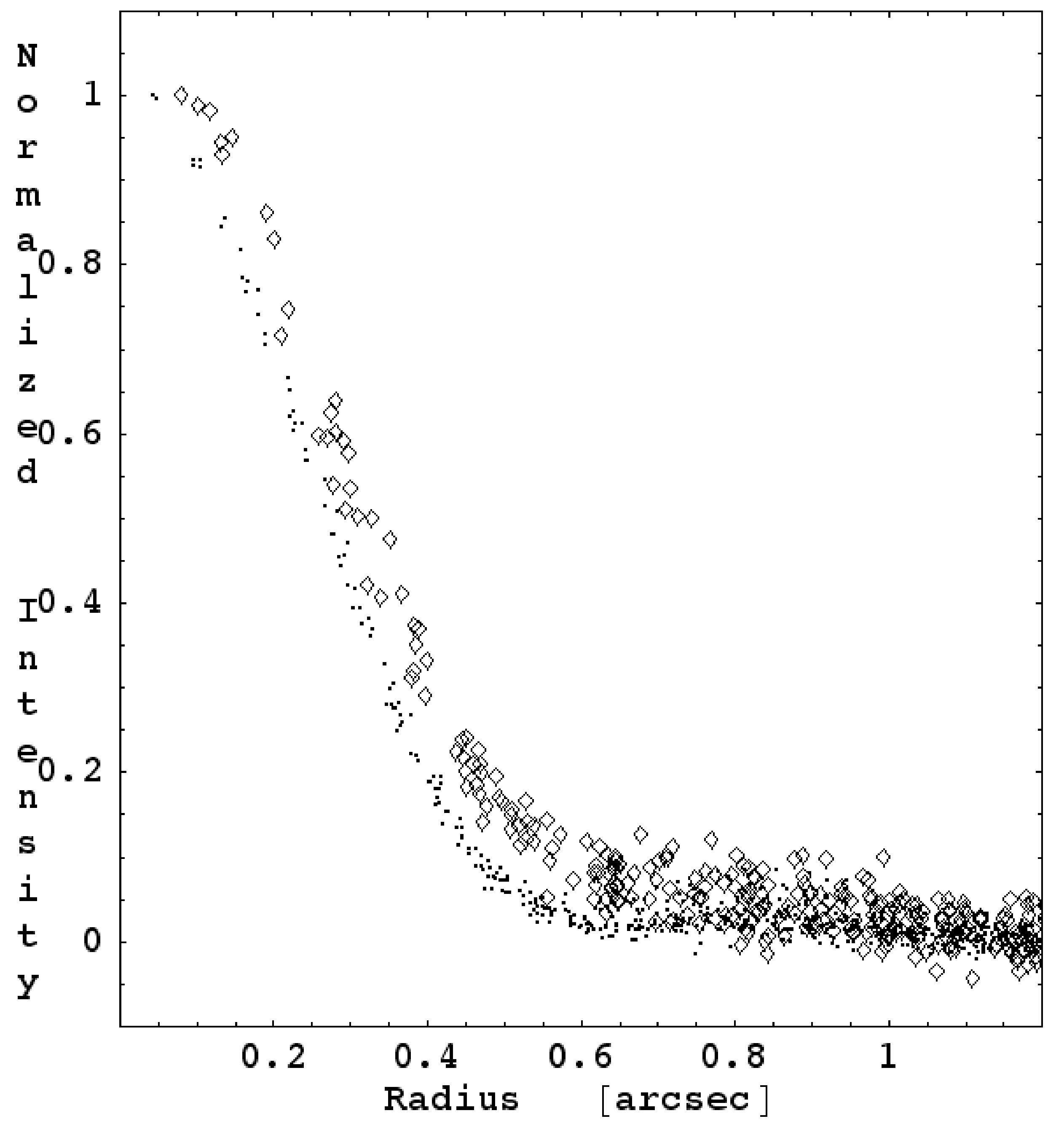 Margaret Moerchen
Margaret Moerchen
Debris
disks surrounding main-sequence stars emit excess infrared flux due to
thermal re-radiation from dust predominantly observable in the
mid-infrared. For dust to be present in quantities capable of
producing such excess emission, it must be supplied continuously
through collisional cascades and other processes. Using
high-resolution (~0.5”) mid-infrared imaging with T–ReCS at Gemini
South, I am exploring the ongoing physical processes within these disks.
One
of the first objects to have been observed in the sample of over a
dozen selected sources is the debris disk of zeta Leporis. This
source was discovered by IRAS in 1991 to have a significant infrared
excess, which has been confirmed recently with Spitzer photometry and
is unusually bright for a disk of its estimated age. In
preliminary comparisons of zeta Lep with the PSF star, the azimuthally
averaged 10.4 micron profiles indicate similar FWHMs; thus, the source
remains unresolved at 10.4 microns (consistent with previous Keck
observations). However, at 18.3 microns, the FWHM of zeta Lep appears
more extended than the PSF by ~0.05”, corresponding to a diameter of 5
AU for the compact disk emission. In addition to the extension
shown by the FWHM difference, the radial profiles indicate lower-level
wings of emission potentially indicating the presence of further
extension in the disk. Disk models capable of producing similar
emission profiles are presently under investigation.
Near
Infrared Interferometry
of Young Stars: IOTA-3T and KI
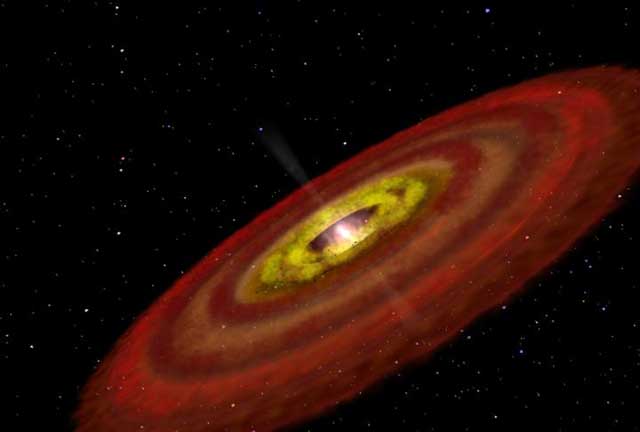 Rafael Millan-Gabet
Rafael Millan-Gabet
Looking for planets by their dusty fingerprints
Amaya Moro-MartinMain sequence stars are commonly surrounded by debris disks, composed of cold far-IR emitting dust presumably generated by a reservoir of undetected dust-producing planetesimals. In debris disks harboring massive planets, the trapping of dust in gravitational resonances with the planet creates a density enhancement in a ring-like structure outside the orbit of the planet, while gravitational scattering with the planet creates a clearing of dust inside the planet’s orbit. Massive planets, therefore, can create structure in the dust disk, and the study of this structure can help us survey a range of planetary parameters that are not detected by other methods. The Spitzer infrared space telescope has began to obtain spatially unresolved spectrophotometric observations of many potentially diverse debris disk systems with embedded planets. In this talk, we will briefly summarize some of these results. In view of these observations we will discuss how the structure carved by massive planets affects the shape of a debris disk’s spectral energy distribution (SED), and consequently how the SED may be used to infer the presence and properties of planets. However, we will see that the SED modeling presents some degeneracies that can only be broken if spatially resolved images of the dust disks are obtained.
The Search for Planets Around White Dwarf Stars
Fergal Mullally
I report on recent progress in the search for planets around white dwarf stars. My principle method surveys a subset of pulsating white dwarfs stars with pulsational stability that exceeds most pulsars and rivals that of atomic clocks.
We search for periodic modulation of the average pulse arrival times. The reflex orbital motion of the star around the star-planet center of mass causes the line-of-sight distance to vary with the orbital period; changing the light travel time. The amplitude of our signal increases linearly both with the mass of the planet and its distance from the star, allowing us to probe a region of mass-orbital separation space largely inaccessible by other methods.
I also report on recent results from our search for the infra-red signature of planets around white dwarf stars. The very low luminosity of a white dwarf is comparable to that of a planet at infrared wavelengths, opening the prospect of the direct detection of light from an extra-solar planet. I report on the results of a survey of 130 white dwarf stars with the Spitzer space telescope.
PHASES: The Palomar High-precision Astrometric Search for Exoplanet Systems
Matthew W. Muterspaugh
Popular prejudice has that planet formation is difficult or inhibited in binary or multiple stars. However, eightteen of the current sample of over a hundred of extrasolar planets are in binary or multiple systems. With roughly 57% of star systems being multiples, the issue of planets in binary systems is an important topic for understanding planets in general.
For reasons of observational difficulty, narrowly separated binaries have been avoided by most searches for extrasolar planets. I will discuss why searches for planets in binaries can help determine which of several proposed methods of giant planet formation occur in nature, and present one such search being conducted at the Palomar Testbed Interferometer. Initial results will be presented from this search, including applications to the study of binaries themselves in determining high precision stellar masses and studying the configuration of a triple star system.
Searching for Extrasolar Planets with Simultaneous Differential Imaging
Eric Nielsen
Simultaneous Differential Imaging (SDI) is a promising technique to provide direct images of extrasolar giant planets, and simulations based on our measured sensitivities suggest that our newly commissioned SDI devices (operating on the MMT and VLT telescopes) should have between 10-50% chance of detecting planets around the nearest, youngest stars in our program. By using the gas giant planet models of Burrows et al. 2003, as well as extrapolations of extrasolar planet populations from the radial velocity survey, we are able to quantitatively determine the likelihood that a planet around any of our target stars can be detected by our technique. For a 100 Myr K-dwarf, the SDI technique is sensitive to 4 Jupiter mass companions at 8 AU, or 2 Jupiter masses at 30 AU. Given this precision and our simulations, we expect our current SDI surveys to begin yielding planet detections within two years, or else place very stringent constraints on the population of extrasolar planets not sampled by the radial velocity method. Our survey has already begun to yield results, with our detection of AB Dor C (See Close et al. 2004), a 90 Jupiter mass pre-main sequence star with an astrometric orbital solution. For the first time, we are able to calibrate the mass-luminosity relation for young, low-mass objects. Since most direct imaging surveys for planets rely on these theoretical tracks, calibrating the models with observational data is of great interest for the field of extrasolar planets.High Angular Resolution Studies of Circumstellar Disks
Jennifer Patience
Observations of disk material surrounding young stars determine the early environmental conditions that influence the development of planetary systems and provide constraints on theoretical models of star and planet formation. With a series of high angular resolution programs, I am investigating the hot inner region of disks that corresponds to the zone of terrestrial planet formation and the cool outer disk that encompasses most of the disk mass and is critical to giant planet formation. The infrared, submillimeter, and millimeter data provide detailed measurements of the disk structure, the influence of companions on dust distribution, and the dependence of disk properties on stellar mass. Keck interferometry observations of several pre-Main Sequence stars show calibrated squared visibilities significantly less than unity, indicating spatially resolved hot inner disks at sub-AU scales. The inferred sizes are more consistent with disk models incorporating a puffed-up inner edge at the dust destruction radius than standard flared disk models, however the inner disk sizes are somewhat larger than the dust destruction radius. Longer wavelength data in the submm are being used to study the dependence of disk mass on central object mass across the stellar/substellar boundary. Finally, millimeter interferometry observations of young binaries at different evolutionary stages in Taurus and Ophiuchus provide estimates of disk lifetimes that impact planet formation and reveal the influence of companion stars on disk frequency and disk mass.High angular
resolution observations of the
cool giants V Hya and R Leo
Ettore Pedretti,
John S. Young, John D. Monnier,
Julien Coyne, Wesley A. Traub, Rafael Millan-Gabet, Jean-Philippe
Berger, F. Peter Schloerb, Marc G. Lacasse.
We present the preliminary interferometric observations of two cool giant stars, performed in 2004, and 2005: the carbon-rich star V Hya, and the Mira star R Leo. V Hya, which is known to have mass-loss and to be surrounded by a dust shell,was observed in a standard H bandpass at the Infrared Optical Telescope Array (IOTA), using the IONIC three-telescope beam combiner. R Leo, which is a Long Period Variable star was simultaneously observed in three narrow band-passes in H band at the IOTA interferometer and in four visible, narrow band-passes at the Cambridge Optical Aperture Synthesis Telescope (COAST). This is the first time that a star is simultaneously observed by two long-baseline interferometers measuring visibility and closure-phase quantities in several bandpasses, at the same time. We discuss the results and try to fit simple models to the observed data.
High Contrast Coronagraphy Today: Lyot Project Status and Results
Marshall Perrin
The Lyot Project Coronagraph was built to take advantage of the AEOS telescope’s advanced AO system to test high contrast imaging techniques today. The Air Force AEOS telescope currently possesses the world’s highest order astronomical AO system with 941 actuators, enabling near-IR observations at higher Strehl Ratios than any other ground-based facility. Our coronagraph saw first light in March 2004, and has had five observing runs since then, carrying out a survey of nearby stars for substellar companions. Since our first run, we have also improved the instrument through upgraded software, an infrared tip-tilt system, and the addition of a polarimetry mode. I will describe the current status of the project, discuss the performance of the AEOS AO system and the coronagrah, and present results from our imaging and polarimetry surveys.Laboratory Demonstration of a Focal Plane Coronagraphic Interferometer
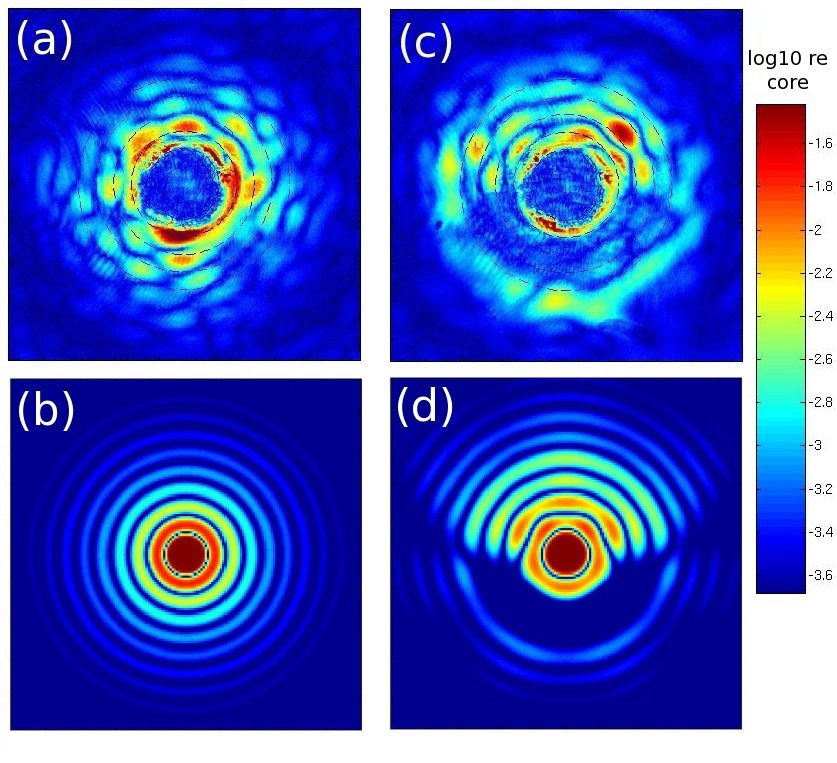 Nicole M. Putnam
Nicole M. Putnam
Laboratory development of a focal plane coronagraphic interferometer will be presented. The prototype takes a simulated imperfect star image and suppresses the halo on the basis of interferometric measurements of complex amplitude made in the focal plane. The current system employs one MEMS DM as the corrective element placed in a pupil plane. Future systems are envisioned using MEMS and/or liquid crystal devices conjugated to the focal plane and used to generate an “anti-halo” to interfere destructively with the star halo. The concept, design, and implementation of the instrument, intended to enhance the planet-finding abilities of TPF, will be discussed. Current laboratory results are encouraging and will be presented along with concept developments for the various applications of this technology. This laboratory development has and will continue to allow us to gain insight into the difficulties to be faced in detecting exoplanets optically.
Detection of Asymmetries in AGB stars
Sam Ragland
We have measured non-zero closure phases for about 25% of our sample of 56 nearby Asymptotic Giant Branch (AGB) stars, using the 3-telescope Infrared Optical Telescope Array (IOTA) interferometer at near-infrared wavelengths (H-band) and with angular resolutions in the range 5-10 milliarcseconds. These non-zero closure phases can only be generated by asymmetric brightness distributions on the target stars or their surroundings. The occurrence of asymmetry tends to correlate with pulsation period. We discuss how these results were obtained, and how they might be interpreted in terms of structures on or near the target stars. We also present a novel method for obtaining photometrically-corrected interferograms.
IR interferometry of massive evolved stars
Jayadev Rajagopal
We present first results from long-baseline observations of dusty massive stars. These include mid-IR data from VLTI observations of dusty LBV-type objects and near-IR Keck-I observations of dust-producing WR binary systems. The Keck-I data suggests that we have spatially resolved two binary systems (WR 140 and WR 137) which will enable us to constrain the dust formation models involving wind-wind collisions. The VLTI observations have resolved for the first time the angular size of the dust cocoons of massive stars believed to betransitioning from the LBV to WR phase. We also present some data from observations of WR stars with the IOTA 3 telescope interferometer. We briefly show results from simulations to test the feasibility of imaging debris-disks around nearby stars with a proposed concept for an IR space inteferometer, the FKSI.
Understanding the role of speckle statistics in high dynamic range imaging
Rémi Soummer
The detection of faint sources around stars is limited by several sources of noise, mainly as a result of the diffracted light. In the presence of small wavefront aberrations, the residual speckles which appear in the field are generally the limiting factor. It is crucial to understand the properties of these remnant speckles to be able to analyze and predict instrument performance. Using reasonable assumptions, it is possible to model the statistics of these speckles using a modified Rice distribution. Simple expressions can be derived to estimate the speckle noise contribution. As an immediate result, the so-called “speckle pinning” phenomenon can be explained from this theory as an amplification of the speckle fluctuation on the bright Airy rings. The theoretical Rice statistics agrees with numerical simulations of Adaptive Optics PSFs, and with ground-based data from Lick and Palomar telescopes. This approach is completely general, which makes it valid for both space and ground-based observations, with different spatial and temporal properties. The effect of a coronagraph on the photon and speckle noise can be derived from their statistics. This can provide a tool to predict and understand the dynamic range of a coronagraph. These results are compared to the actual dynamic range obtained with the Lyot Project Coronagraph.Investigating the Circumstellar Disks of Hot Stars using Long-baseline Interferometry
Christopher Tycner
Among the hot stars that are classified as B-type stars there exists a very interesting class of stars that possess circumstellar regions with much higher densities than expected for radiation driven winds of stars of similar effective temperatures and masses. These stars are known as Be stars and their common observational characteristic is that they show significant Balmer line emission. The line emission originates from what is thought to be a disk-like structure formed by an outflowing material from the central star. Although, long-baseline interferometry already has contributed to our understanding of these objects by observationally verifying that the circumstellar regions are indeed flattened, many issues still remain unresolved. For example, disk formation mechanism(s) are poorly understood, including the possible connection to the rapid rotation typically observed in these stars. For those Be stars that are also in binaries, the disk interaction with the secondary has not been observationally investigated, although the initial interferometric observations suggest that disk truncation occurs. I will describe how the Navy Prototype Optical Interferometer is being utilized in the study of the circumstellar regions of Be stars. Recent results shedding light on the properties of the Be disks as well as the current and future directions will also be presented.The Exoplanet Tracker: Data Reduction and Latest Results
Julien van Eyken
The Exoplanet Tracker (ET) is a new precision radial velocity instrument that has been installed at the KPNO 2.1m telescope. Employing new technology based on externally dispersed fixed-delay interferometry, this single-object instrument is a precursor to a second more sophisticated multi-object instrument that is being installed at the Sloan multi-fiber telescope at Apache Point in New Mexico.In a recent small-scale survey using the 0.9m Coude Feed housed in the same building as the 2.1m telescope, preliminary results suggest we have been able to detect radial velocity signatures in previously unsearched stars that are consistent with those expected from close companions, showing recision matching the expected photon limit of around 20-30m/s at visual magnitudes 8-9. Best short-term precisions at the 3m/s level have been previously obtained using the 2.1m, and we are able to routinely recover the signatures of known short-period planetary companions.
The technology has required the development of new data reduction techniques and software. Here I will discuss some of the aspects of the data reduction, and present new results from both the single and multi-object instruments.
Expected Productivity-Based Risk Analysis In Conceptual Design: With Application To The Terestrial Planet Finder Interferometer Mission
Julie Wertz
During the early design process, risk is mentioned often, but very infrequently actually impacts major design or architecture decisions. One parameter that is almost always used when making design decisions is the productivity. If it were possible to examine the expected productivity, taking into account failures and risk items, the concept of risk could be brought into the design process in a very quantitative, understandable, and tradable way.Previous expected productivity modeling work has relied on the productivity being path-independent. While this assumption greatly simplifies calculations, it is an invalid assumption for many real life systems. An example system with path-dependant productivity is the Terrestrial Planet Finder Interferometer (TPF-I) mission. With TPF-I, the time required to complete a survey of a star system, or the productivity, is determined not only by the state of the instrument, but also by the stellar characteristics of the particular star system being surveyed. In this case, the expected productivity would be defined as the expected number of stars a system could survey in a given lifetime. An approach has been developed to model these path-dependant productivity systems in an efficient and effort saving manner. This new approach has been tested for the example case of the TPF-I mission against Monte Carlo simulations with excellent results. Once validated, the new approach was used in two different case studies using the TPF-I mission to include risk in very early design trades and analyses using expected productivity. The new analysis method as well as both case studies, including preliminary results, will be presented.
Web curator: Gerard van Belle
